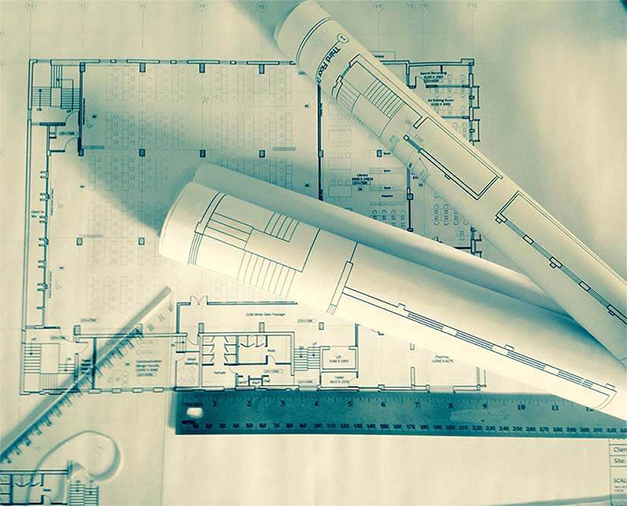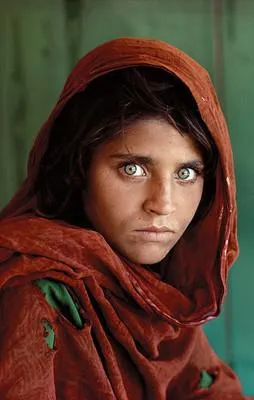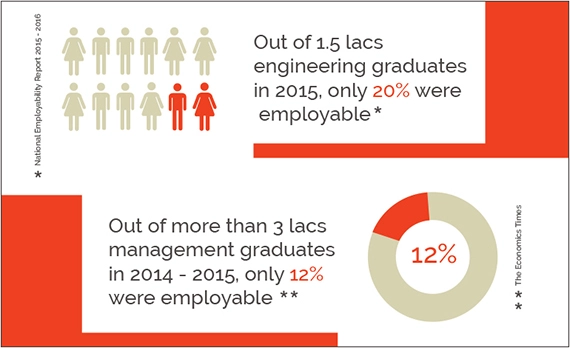Of the 9 planetary boundaries identified, 3 have been compromised - climate change, rate of biodiversity loss and changes to the global nitrogen levels! A recent research paper stated that, anthropogenic (human) activities are causing climate to change 170 times faster than natural forces! Source: The Guardian Such alarming statements and facts have become commonplace on the internet when one searches for ‘human impact on environment’. If this does not make us sit up and take note, then we wonder what will!
What is Sustainable Design?
Oxford dictionary defines the word ‘sustainable’ as ‘able to be maintained at a certain rate or level’. Furthermore, sustainability has three aspects to it - social, economic and environmental and in this article, we would be dwelling upon the environmental impact of design across disciplines. Therefore, sustainable design would imply taking all these aspects into consideration while designing a garment, print collateral or building.
Sustainable design is all about reducing human impact on environmental systems and designing a product without compromising its functionality and profitability. Sustainability in design is not limited to the materials used rather, extends to the production method as well as the entire lifecycle of the product. Since the time humans have set foot on Earth, we have primarily indulged in ‘extracting’ the Earth’s resources without paying much heed towards ‘replenishing’ them. It's about time that we take note of the alarm raised by global powers at various international conventions and congregations held with regard to mitigating the harmful impact of human action on Earth’s natural resources.
The need for ‘sustainability’
It is important to note that companies, big or small, must make a conscious effort at introducing ‘sustainability’ right at the initial stages of concept development so that it permeates effortlessly through the entire design process. It should be something that is intrinsic rather than seeming like a superficial addition! It would be prudent to adopt the cradle-to-grave approach that covers all aspects right from material acquisition to the manufacturing processes and down to product maintenance.
"Design is the problem as well as the solution". - Nathan Shedroff, Californian design professor
Design is omnipresent, it is all around us! Therefore, designers must be cautious of the environmental impacts of the material, production method, packaging, distribution and product’s performance. One of the major roles of designers is to identify the problem and leverage their lateral thinking abilities to find viable solutions for the said problem and deliver upon them. Investing their time in thoroughly understanding the lifecycle of the product would help them make greener and more pragmatic design decisions that involve judicious use of Earth’s fast depleting resources. Taking a resolve towards incorporating ‘sustainability’ as a sustainable design practice across businesses will help arrest scaling of pressing issues like scarcity of resources and global warming.
Examples of sustainable design from the design industry
Irrespective of the design discipline, sustainability can be infused within the design framework without compromising the functionality, profitability and aesthetic appeal of the product. Let us look at some examples where designers have used design thinking to create products that are highly sustainable yet worth every praise for their exceptional design.
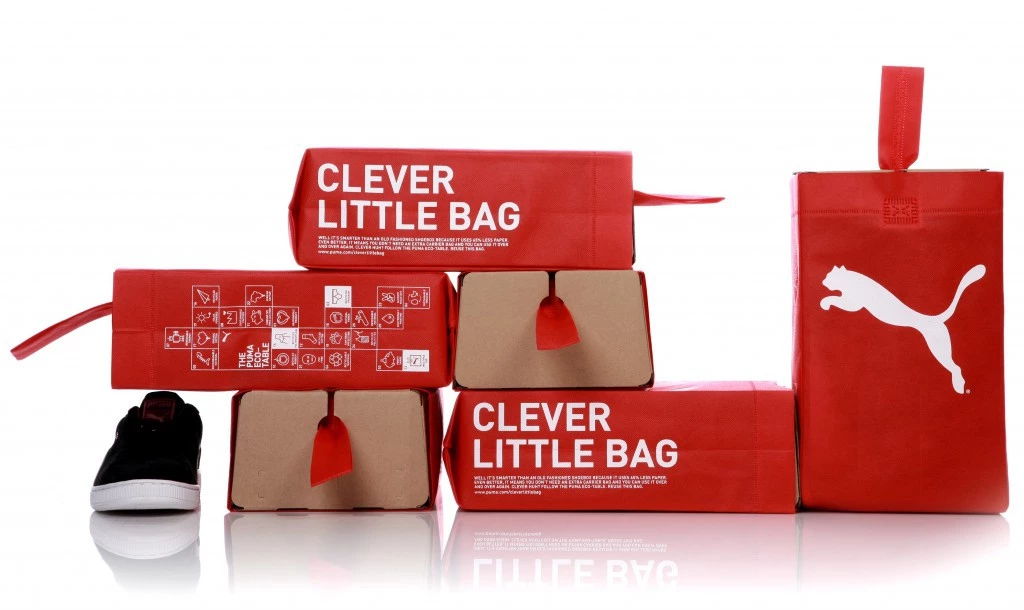
What you see above is the ‘Clever Little Bag’, a sustainable design solution fabricated by Yves Behar for the German multinational company, Puma. A concept that took over 21 months, 2000 ideas and roughly 40 prototypes to finally become a viable design! But, how is this ‘clever’? Let us shine some light on this. This little bag is genius in more ways than one. To begin with, this eco-friendly packaging uses 65% less cardboard than the traditional shoebox would. It takes up less space, weighs less while shipping, involves no lamination and printing costs, and drastically slashes the waste produced as it is a non-woven bag (stitched with heat). There’s more to the tremendous environmental impact of this genius packaging design, the Clever Little Bag not only follows the sustainable design solution but also carries it through to the packaging and distribution life cycle as indicated in the illustration below.
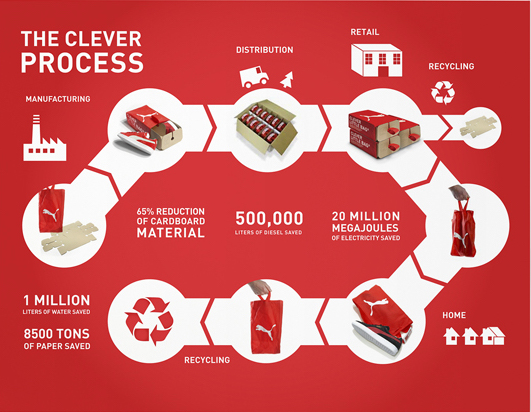
Did you know that the global fashion (garment) industry is the second most polluting industry in the world after Petroleum? This can be attributed to the global supply chain that includes environment harming processes like cotton farming, fibre manufacturing, dyeing, printing and bleaching. In order to curb this gargantuan damage caused to the environment, brands are resorting to a sustainable design philosophy in order to curb their carbon footprints. They are drawing inspiration from myriad creations existing in nature and designed fabrics that offer more sustainable options when compared to man-made ones.
A colossal amount of plastic trash ends up in the oceans every single year with over 40 million pounds of plastic being accumulated in the North Pacific Ocean alone! To stall the risk of potential extinction of marine life, sportswear giant, Adidas, has taken the initiative and designed swimwear range and sports shoes from upcycled fishing nets and plastic debris in collaboration with the ‘Parley for the Oceans’ initiative.


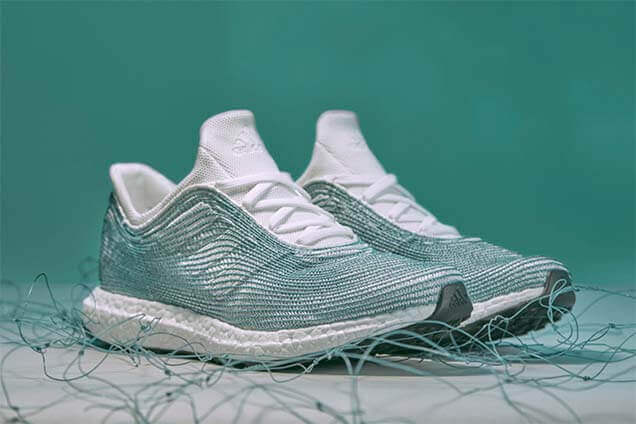
"A designer can be the agitator and the agent for change. He must be entrepreneurial in spirit, seeking out collaborators to reach amazing solutions which outperform and offer truly viable alternatives to current methods." - Alexander Taylor (London-based footwear designer for Adidas)
The new range of swimwear has been designed with Econyl, a yarn fibre made using ocean plastic. This material has the same properties as the regular nylon used for making swimwear. Upcycled gill nets were used in the sports trainers made using the existing Adidas footwear manufacturing process. Through these sustainable products, Adidas has led by example and sent out a clear message to the global corporate giants to help raise environmental awareness and work towards providing sustainable design solutions.
There are a number of eco-friendly fabrics available in the market like, soy fabric (made from tofu manufacturing waste), recycled polyester, industrial hemp, organic cotton, organic wool, bamboo amongst others, engineered using sustainable production methods. Infact, SeaCell is a fabric made using eucalyptus fibre and seaweed and is known to be the most sustainable natural fibre till date! Seaweed is known to boost the immune system, promote circulation and digestion, reduce blood sugar, and even revitalise your skin, hair and nails. Who would have thought that a fabric can have such mind-boggling healing properties!
With globalisation, urbanisation, infrastructure development and mounting needs of developing markets being the order of the day, Accenture in one of their reports, has stated that construction in the emerging markets would double to become a $6.7 trillion business by 2020. What do these numbers imply? Such a growth in construction would necessarily mean a pressing need and demand for building interiors that need to be sustainable in order to reduce the already caused ecological damage.
The interior architecture and design community has left no stone unturned in devising novel ways to repurpose and redesign projects using sustainable materials. One such discovery is ‘cork’. From being traditionally used as a bottle stopper, to graduating as a sustainable material in flooring, walls, furniture, tableware, and clothing. In fact, NASA has been known to use cork for the isolation of their space shuttles! The reason this woody material is widely used in building interiors is because of the fact that it is cellular, elastic, thermal regulating, sound-proof and fire resistant too! Portugal is the world’s largest producer of cork as the material is obtained from cork oak tree that is native to Portugal and the mediterranean environment.
This eco-friendly material is extracted directly from nature (bark of the cork oak tree) and requires minimal processing. The extraction process does not harm the tree at all and every 9 years there is a new bark to be removed. The ecological footprint of cork right form extraction up until the final use in a product is way lesser than other harmful materials like plastic. Gradually, this material is figuring as a favourite in the design community owing to its inherent durability and flexibility.
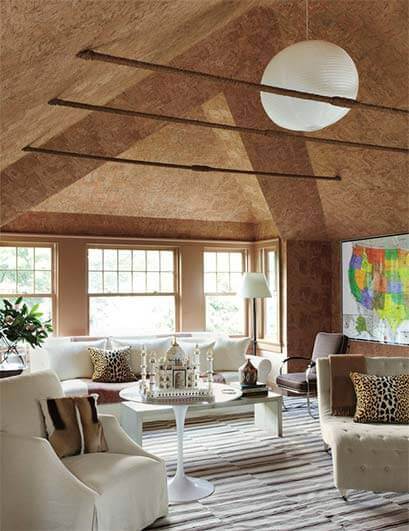
The above are just some of the many efforts made in the direction of infusing sustainability into the universal design language. We need to channel our energies towards adopting a more sustainable outlook in all spheres of our lives. In order to weave the aspect of sustainability into design philosophies across the globe, design education would have to necessarily embrace sustainability as a core module in their respective curricula. Sustainability has certainly made progress from merely lurking in the background to grabbing centre stage in myriad design processes, but considerable efforts need to be taken to help it evolve into a resilient common practice.
Explore: Sustainable Fashion Designing: Way to ‘Greener’ Future
PLAGIARISERS BEWARE!
This Website and its contents are subject to copyright protection under the Indian Copyright laws and, through international treaties for/ of other countries. The copyright in the contents and materials available on this Website as a whole is owned by the IIAD. However, the copyright in some contents and materials incorporated within this Website may be owned by third parties where so indicated. No part of the contents or materials available on this Website may be reproduced, licensed, sold, published, transmitted, modified, adapted, publicly displayed, broadcast (including storage in any medium by electronic means whether or not transiently for any purpose save as permitted herein) without the prior written permission of IIAD. The visitor may view this Website and its contents using Web browser and save an electronic copy, or print out a copy, of parts of this Website solely for visitor’s own information, research or study, provided the visitor (a) do not modify the copy from how it appears in this Website; and (b) include the copyright notice “© 2014 to 2018 Indian Institute of Art and Design (IIAD). All rights reserved.″ on such copy.
IIAD’s logo/ name should never be removed from pages on which they originally appear. The webpages should always appear exactly as posted without variation unless the prior written approval of the Organisation is obtained.

